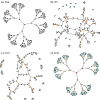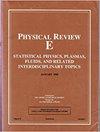使用配置模型和最小描述长度进行网络压缩
IF 2.4
3区 物理与天体物理
Q1 Mathematics
引用次数: 0
摘要
随机网络模型受限于再现特定的统计特征,常用于表示和分析网络数据及其数学描述。其中,配置模型通过度分布对随机网络进行约束,是网络科学许多领域的基础。然而,配置模型及其变体的选择往往基于直觉或数学和计算的简易性,而非统计证据。为了评估网络表示的质量,我们需要考虑指定随机网络模型所需的信息量,以及将该模型用作生成过程时恢复原始数据的概率。为此,我们计算了由流行配置模型及其广义模型(包括考虑度相关性和中心层的版本)生成的网络集合的大致大小。然后,我们将最小描述长度原则作为模型选择标准,应用于由此产生的嵌套配置模型系列。通过使用由来自不同领域的 100 多个网络组成的数据集,我们发现在平均度数超过 10 的网络中,经典配置模型通常更受青睐,而受中心度量限制的分层配置模型则为大多数稀疏网络提供了最紧凑的表示。本文章由计算机程序翻译,如有差异,请以英文原文为准。

Network compression with configuration models and the minimum description length
Random network models, constrained to reproduce specific statistical features, are often used to represent and analyze network data and their mathematical descriptions. Chief among them, the configuration model constrains random networks by their degree distribution and is foundational to many areas of network science. However, configuration models and their variants are often selected based on intuition or mathematical and computational simplicity rather than on statistical evidence. To evaluate the quality of a network representation, we need to consider both the amount of information required to specify a random network model and the probability of recovering the original data when using the model as a generative process. To this end, we calculate the approximate size of network ensembles generated by the popular configuration model and its generalizations, including versions accounting for degree correlations and centrality layers. We then apply the minimum description length principle as a model selection criterion over the resulting nested family of configuration models. Using a dataset of over 100 networks from various domains, we find that the classic configuration model is generally preferred on networks with an average degree above 10, while a layered configuration model constrained by a centrality metric offers the most compact representation of the majority of sparse networks.
求助全文
通过发布文献求助,成功后即可免费获取论文全文。
去求助
来源期刊

Physical review. E
物理-物理:流体与等离子体
CiteScore
4.60
自引率
16.70%
发文量
0
审稿时长
3.3 months
期刊介绍:
Physical Review E (PRE), broad and interdisciplinary in scope, focuses on collective phenomena of many-body systems, with statistical physics and nonlinear dynamics as the central themes of the journal. Physical Review E publishes recent developments in biological and soft matter physics including granular materials, colloids, complex fluids, liquid crystals, and polymers. The journal covers fluid dynamics and plasma physics and includes sections on computational and interdisciplinary physics, for example, complex networks.
 求助内容:
求助内容: 应助结果提醒方式:
应助结果提醒方式:


